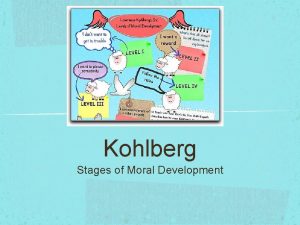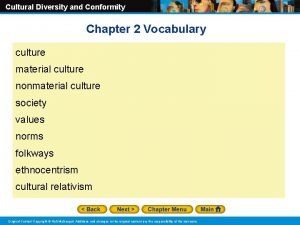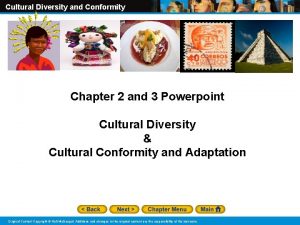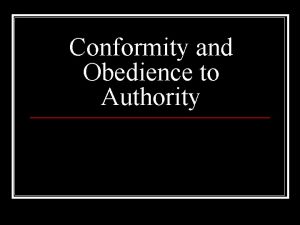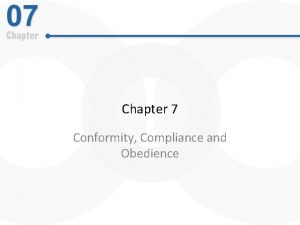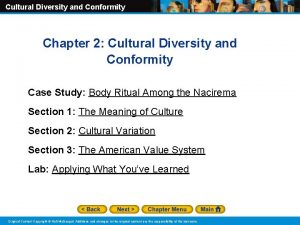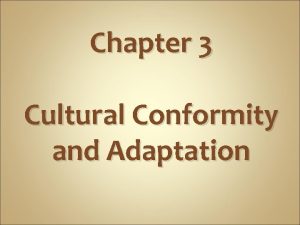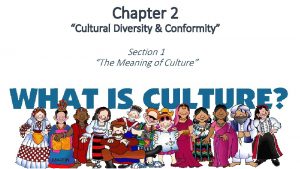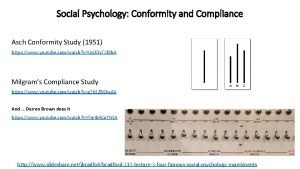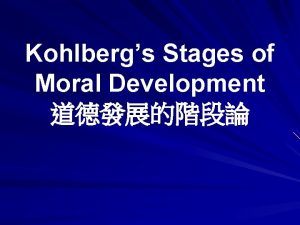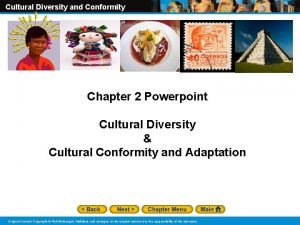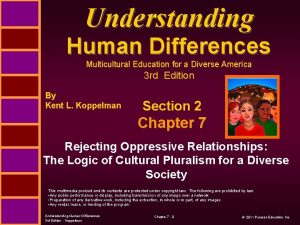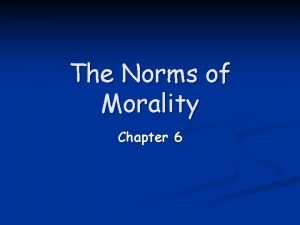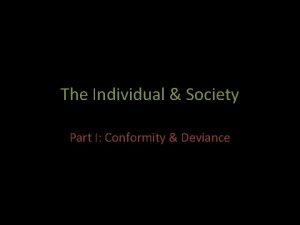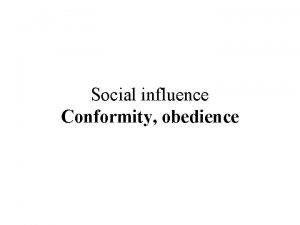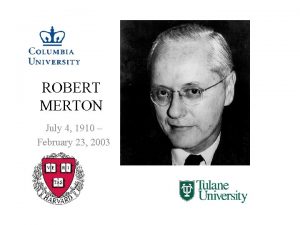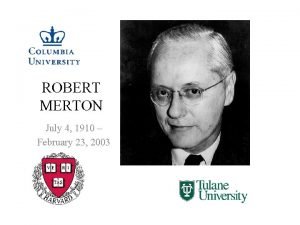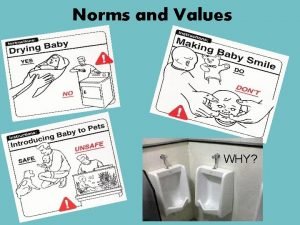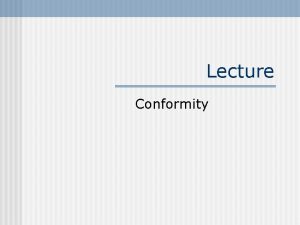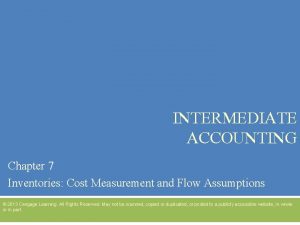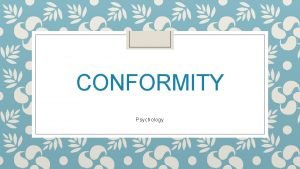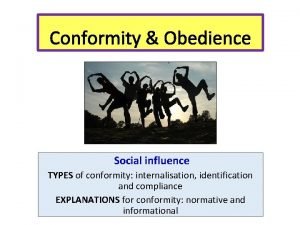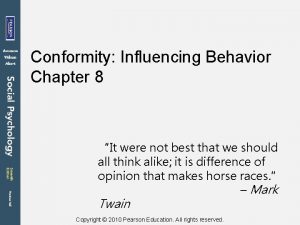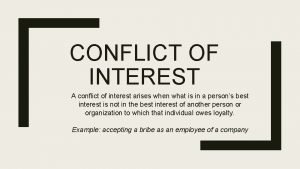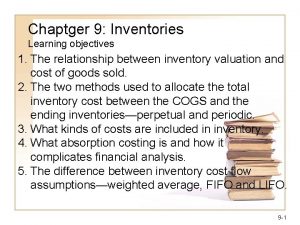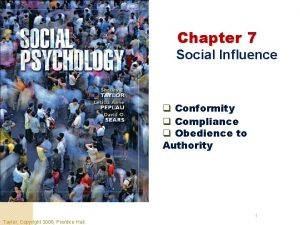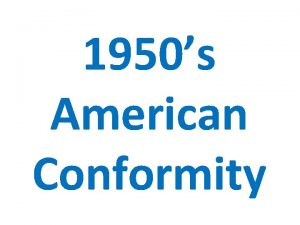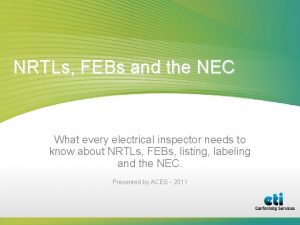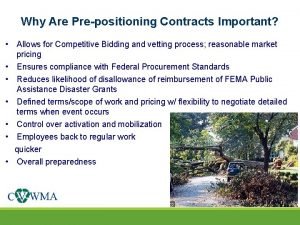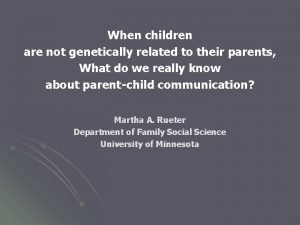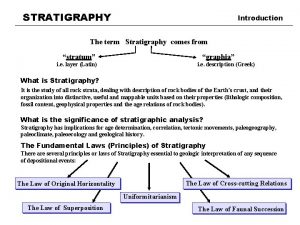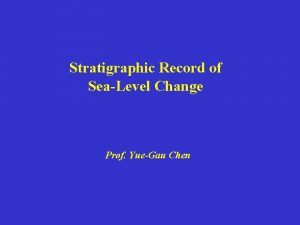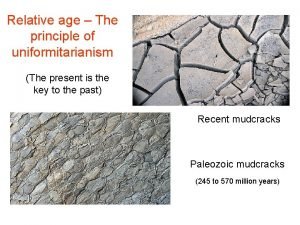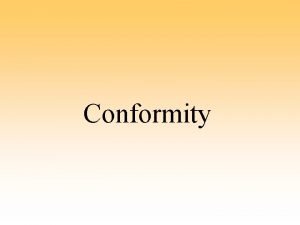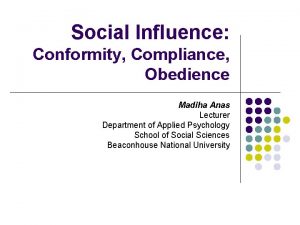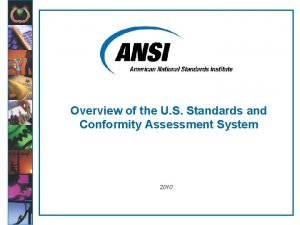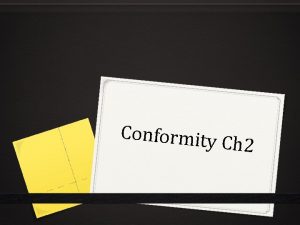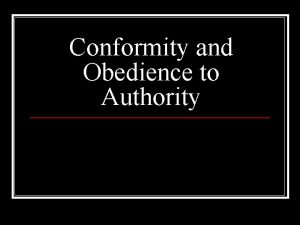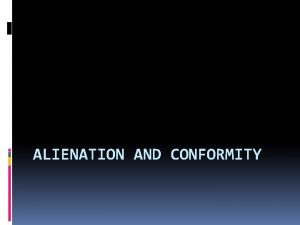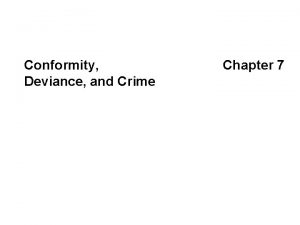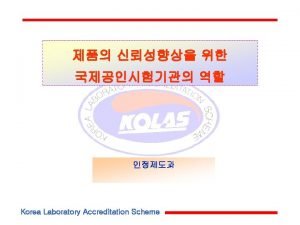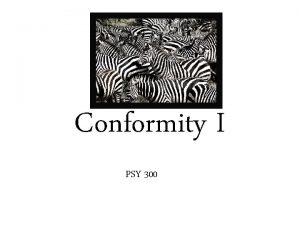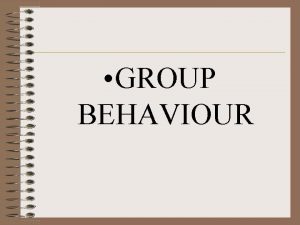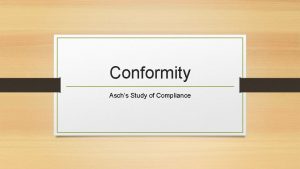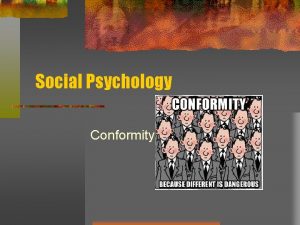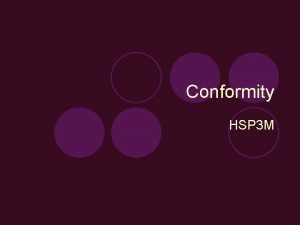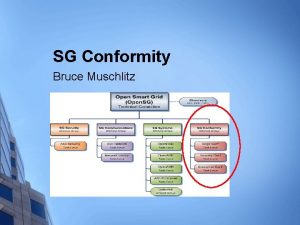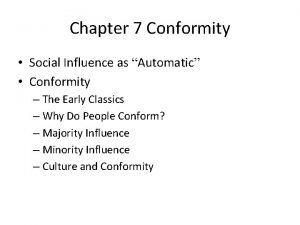Overview of the U S Standards and Conformity

































































































- Slides: 97

Overview of the U. S. Standards and Conformity Assessment System 2010 1

Table of Contents n Importance of Standards and Conformance n The U. S. Approach to Standards and Conformance n Overview of the ANSI Federation n Overview of Conformity Assessment Overview of the U. S. Standards and Conformity Assessment System Slide 2

Importance of Standards and Conformance Overview of the U. S. Standards and Conformity Assessment System Slide 3

Key Terms / Concepts Standards Market-driven specifications for a product, service, person, process or system, with which compliance is voluntary Technical Regulations Mandatory specifications, which may include (or reference) particular standards or conformity assessment procedures Conformity Assessment Processes used to verify the compliance of a product, service, person, process or system to either a standard or a regulation (e. g. , testing, certification) Overview of the U. S. Standards and Conformity Assessment System Slide 4

Statistics: Standards and Trade n According to the WTO, in 2007 global export trade in merchandise surpassed $13. 5 trillion, and global export trade in commercial services surpassed $3. 2 billion n The U. S. Commerce Department estimates that standards impact roughly 80% of all world commodity trade, and that number is growing every day n Those who understand how to effectively influence standardization and compliance programs will have the greatest success in the global marketplace Overview of the U. S. Standards and Conformity Assessment System Slide 5

Importance of Standards and Conformance Standards and conformance impact your bottom line n n When developed and used responsibly, standards facilitate a company’s ability to open and access markets When overlooked, standards can negatively impact a company’s ability to do business in the U. S. and abroad Standards and conformance impact your ability to do business internationally Overview of the U. S. Standards and Conformity Assessment System Slide 6

For example: Coke and Pepsi in India n Full or partial bans of Coke and Pepsi in seven Indian States n Allegations that Coke and Pepsi contain excessive pesticide residue – unsafe n Loss of market share and brand integrity for U. S. soft drink giants n Avoidable with globally acceptable food safety and hygiene standards and certification Overview of the U. S. Standards and Conformity Assessment System Slide 7

The U. S. Approach to Standards and Conformance Overview of the U. S. Standards and Conformity Assessment System Slide 8

Guiding Principles of the United States Standardization System Standards and their related compliance criteria should meet societal and market needs and should not be developed to act as barriers to trade Overview of the U. S. Standards and Conformity Assessment System Slide 9

Guiding Principles of the United States Standardization System The U. S. endorses the globally accepted standardization principles of the World Trade Organization Technical Barriers to Trade Agreement Overview of the U. S. Standards and Conformity Assessment System Slide 10

The WTO Principles Transparency Openness Impartiality and Consensus Effectiveness and Relevance Coherence Development Dimension Overview of the U. S. Standards and Conformity Assessment System Slide 11

The U. S. is supportive of any international standard that: is technically suitable is used throughout a given market sector worldwide, and was developed in accordance with the WTO principles Overview of the U. S. Standards and Conformity Assessment System Slide 12

U. S. Standards and Conformity Assessment System Reliable - Flexible - Responsive n n n Market driven Flexible and sector-based Industry-led and government-supported As defined in the United States Standards Strategy, this system is designed to. . . § Support stakeholder engagement § Address emerging priorities § Allow stakeholders to find custom-fit solutions www. us-standards-strategy. org Overview of the U. S. Standards and Conformity Assessment System Slide 13

United States Standards Strategy (USSS) n Reaffirms U. S. commitment to a sector-based approach to voluntary standardization activities, domestically and globally. n Built upon the traditional strengths of the U. S. system – such as consensus, openness, and transparency – while giving additional emphasis to speed, relevance, and meeting the needs of public interest constituencies. www. ansi. org/usss Overview of the U. S. Standards and Conformity Assessment System Slide 14

U. S. Standards and Conformity Assessment System Reliable - Flexible - Responsive n The National Conformity Assessment Principles for the United States document helps consumers, buyers, sellers, regulators and other interested parties understand key aspects of compliance verification. The NCAP is a guidance document that can be considered in conjunction with the United States Standards Strategy www. ansi. org/ncap Overview of the U. S. Standards and Conformity Assessment System Slide 15

U. S. Standards and Conformity Assessment System comparison with many other economies n Emphasizes private-sector standards solutions n Relies on private-sector compliance verification for both regulatory and non-regulatory functions n Provides greater authority to standards users and stakeholders Overview of the U. S. Standards and Conformity Assessment System Slide 16

U. S. Standards and Conformity Assessment System comparison with many other economies (continued) Top Down Standards bodies drive standardization activities Bottom Up Standards users drive standardization activities Overview of the U. S. Standards and Conformity Assessment System Slide 17

The U. S. System: A Toolbox n Rather than mandating a “one-size fits all” solution, the U. S. system allows users to find the tools and solutions that best fit their needs. n Approaches, philosophies and positions often vary across industry sectors. Such variations are seen as beneficial and are promoted in the “U. S. Standards Strategy. ” Overview of the U. S. Standards and Conformity Assessment System Slide 18

U. S. Standards System Different tools for developing globally-relevant standards National Participation Direct Participation § § Treaty Organizations Non-Treaty Organizations Examples Non-Treaty: ISO, IEC Treaty: ITU, CODEX § § Consortia Nationally Accepted Internationally Accepted Examples ASTM International, ASME, SAE, etc. Examples IGRS, W 3 C, etc. Overview of the U. S. Standards and Conformity Assessment System Slide 19

Summary of U. S. Participation in ISO and IEC ISO n Participation in 620 TCs and SCs (roughly 79% of total) Ø Ø n IEC n P Memberships: 570 O Memberships: 50 U. S. – held International Secretariats: 18% of total Participation in 153 TCs and SCs (roughly 89% of total) Ø Ø n P Memberships: 153 O Memberships: 0 U. S. – held International Secretariats: 14% of total Overview of the U. S. Standards and Conformity Assessment System Slide 20

ANSI: Coordinator for U. S. Participation n U. S. Reps. to ISO Council / IEC CB Ø ANSI staff on ISO Council -- 1 Ø USNC President on IEC Council Board -- 1 n U. S. Reps. to TMB/SMB Ø ANSI Staff – 1 on TMB and 1 on SMB Ø Volunteers – 1 (on SMB) n ISO and IEC International Secretariats Ø Most U. S. – held Secretariats are administered by volunteers Ø ANSI staff administer U. S. – held Secretariats only at the request of ANSI constituents. Ø 13 U. S. – held Secretariats are administered by ANSI staff. n Leadership of U. S. mirror committees (TAGs) Ø Leadership positions on U. S. TAGs are held by ANSI member volunteers. n U. S. Technical Expert Participation Ø U. S. technical contributions to ISO and IEC are provided by ANSI member volunteers. U. S. Contributions to ISO and IEC ANSI Staff ANSI delegates most ISO and IEC work to volunteers within the U. S. system (e. g. companies, trade associations, SDOs, etc) Overview of the U. S. Standards and Conformity Assessment System Slide 21

U. S. Standards System Different tools for developing globally-relevant standards National Participation Direct Participation § § Treaty Organizations Non-Treaty Organizations Examples Non-Treaty: ISO, IEC Treaty: ITU, CODEX § § Consortia Nationally Accepted Internationally Accepted Examples ASTM International, ASME, SAE, etc. Examples IGRS, W 3 C, etc. Overview of the U. S. Standards and Conformity Assessment System Slide 22

Standards Used in the U. S. : Accredited/Approved Standards n ANSI is responsible for accrediting SDOs and approving standards as “American National Standards. ” n National and international SDOs voluntarily choose to receive ANSI accreditation/approval (the U. S. has no legal requirement) n Accreditation and approval do not guarantee U. S. market acceptance; individual users have complete freedom to choose which standards best suit their needs. n ANSI accreditation and approval processes do not evaluate a standard’s technical merit, but only evaluate the process by which a standard was developed. Overview of the U. S. Standards and Conformity Assessment System Slide 23

Many American National Standards (ANS) are International Standards Criteria WTO/TBT Principles Criteria Reflected in the ANS Process Transparency Openness Impartiality & Consensus Effectiveness & Relevance * Coherence Development Dimension ** * Although the ANS process does not directly evaluate Effectiveness & Relevance, adherence to the other ANS criteria helps to assure the effectiveness and global relevance of ANS. ** Although the ANS process does not evaluate for this criteria, it is strongly Overview of the U. S. Standards and Conformity Assessment System encouraged in the U. S. Standards Strategy, and many SDOs engage in extensive international outreach and development activities Slide 24

Examples of ANSI-Accredited SDOs ASTM International American Society of Mechanical Engineers American Dental Association National Electrical Manufacturers Association Society of Automotive Engineers American Society of Civil Engineers International Code Council National Fire Protection Association Institute of Electrical and Electronics Engineers Underwriters Laboratories Inc. American Petroleum Institute And more than 200 additional organizations Overview of the U. S. Standards and Conformity Assessment System Slide 25

Getting Involved in U. S. -Based SDOs Overview of the U. S. Standards and Conformity Assessment System Slide 26

Getting Involved in U. S. -Based SDOs (2) Overview of the U. S. Standards and Conformity Assessment System Slide 27

U. S. Standards System Different tools for developing globally-relevant standards National Participation Direct Participation § § Treaty Organizations Non-Treaty Organizations Examples Non-Treaty: ISO, IEC Treaty: ITU, CODEX § § Consortia Nationally Accepted Internationally Accepted Examples ASTM International, ASME, SAE, etc. Examples IGRS, W 3 C, etc. Overview of the U. S. Standards and Conformity Assessment System Slide 28

Standards Used in the U. S. : Consortia Standards n Consortia consist of groups of like-minded participants who place a priority on developing standards quickly enough to meet market demands or to harmonize or differentiate specifications within an industry. n Hundreds of consortia organizations operate in the global economy. Many have global membership, including both U. S. and international companies. n Consortia usually have a narrow focus, with some only developing a single specification. However, some consortia are very broad and develop a large number of standards (examples: W 3 C, OASIS, etc. ) n Companies often rely on consortia standards in areas where the technology changes rapidly. Overview of the U. S. Standards and Conformity Assessment System Slide 29

U. S. Standards System Multiple Path Approach to Standard-Setting n Traditional SDOs and consortia each have a role to play n Consortia and other forums have become more clearly recognized – and embraced – as an integral part of the global standards system Overview of the U. S. Standards and Conformity Assessment System Slide 30

The Role of Government in the U. S. Standards and Conformance Systems Overview of the U. S. Standards and Conformity Assessment System Slide 31

U. S. Standards and Conformity Assessment System The public-private partnership n No single government agency has control over standards Ø n Each agency determines which standards meet its needs National Technology Transfer and Advancement Act (NTTAA) (Public Law 104 -113) Ø Encourages each government agency to seek existing private sector standards that are appropriate for its purpose and mission Overview of the U. S. Standards and Conformity Assessment System Slide 32

The Role of Government Agencies n OMB Circular A-119 n The National Technology Transfer and Advancement Act (NTTAA, Public Law 104 -113) Ø Ø Ø Before regulating, each government agency is required to seek and consider using existing private sector standards that are appropriate for its needs If so, the agency will use (i. e. reference) the private sector standard If not, the agency is expected to work with the private sector to develop the needed standards, and to reference them in its regulations Agencies creating their own standards must report to the Administration and Congress on an annual basis the justifications for doing so NIST has the legal responsibility of implementing the NTTAA Overview of the U. S. Standards and Conformity Assessment System Slide 33

The Role of Government Agencies n Significant elements of OMB Circular A-119 and The NTTAA: Ø U. S. regulators and procurement officials can use any standard from any source in the world which help them meet their Congressional mandates Ø These standards do not need to first be transposed into American National Standards by ANSI Ø These directly referenced standards include ISO, IEC, SDOs Ø These standards may also be consortia standards Ø Regulators and procurement officials may make reference to applicable parts of standards – i. e. are not limited to referencing only whole standards Overview of the U. S. Standards and Conformity Assessment System Slide 34

Structure of the U. S. Standardization System n ANSI – Coordinator of the Private Sector led System Ø Ø Ø n Standards Developing Organizations (SDOs) Ø Ø Ø n Responsible for the development of standards for the specific technical sectors Some, but not all, accredited by ANSI When accredited, can administer U. S. mirror committees to ISO and IEC Private trade and professional organizations, often non-profit Business models vary by sector Conformity Assessment Bodies (CABs) Ø Ø n Responsible for coordinating U. S. private sector participation in the U. S. private sector led Standards and Conformance systems The National Standards Body for the United States – Represent the U. S. in intl. and regional standards fora An Accreditation Body for private sector programs – Represent the U. S. in intl. and regional accreditation fora Private sector, non-profit, membership organization Supported by membership fees, sale of publications, funded programs, accreditation programs and periodic government grants Testing Laboratories, Certification Bodies, Inspection Bodies Responsible for demonstrating compliance with standards (including those referenced by mandatory technical regulations) Some, but not all, accredited by ANSI Business models vary by sector (non-profit, for-profit, public sector, etc. ) NIST – National Institute of Standards & Technology – U. S. Department of Commerce Ø Ø Coordinates the activities of Federal agencies in the U. S. private sector led Standards & Conformance Systems National Metrology Institute for the U. S. – Represents the U. S. in international and regional metrology fora Accreditation Body for public sector programs – Represent the U. S. in international and regional accreditation fora U. S. government public sector body Overview of the U. S. Standards and Conformity Assessment System Slide 35

U. S. Standards System Examples of roles and responsibilities *Documentary Standards, excluding “national participation models” Overview of the U. S. Standards and Conformity Assessment System Slide 36

U. S. Standards System: policy development Overview of the U. S. Standards and Conformity Assessment System Slide 37

Standards and Conformity Assessment Bodies of the U. S. APMP IAAC TS SSD NVCASE ITAC 16 ANAB accredited QMS/EMS Certifiers ANSI accredited Product Certifiers ANSI accredited Personnel Certifiers SDOs with ANSI accredited procedures SSOs & Consortia without ANSI accreditation Certified Personnel ANSs (American National Standards) Non-ANS Standards Certified Products (Processes, Services) IPRPC USNC Technical US IEC ISO TAGs USNC IEC IEC TAGs Board Members US Private & Government Sectors: Organizations, Government, Companies, Trade Associations, Consumers, Educational Institutions, Individuals, Others ITU Sector Members Executive Office Of the President Other Agencies Regional International Government USPS DHS FEMA VA Treasury DOT NHTSA EB CIP State DOL OSHA DOJ DOI HUD Legend NSF ITU TPSC SC-S&TB ITAC ACICIP NRC CITEL APEC/ SCSC (Members) TSP OIE Other SDOs ICSP NASA APEC-TEL FDA HHS NPC ANSI ITC IPPC PPQ DOEd DOE ES&H DSP DOD Essential Requirements GSA USCO (Standardization-Telecom) Cabinet Departments USDA IPC ISO/IEC 17024 FCC FAS DOC CAPC ISO/IEC Guide 65 FTC FAO CODEX USDA APHIS Policy (Accreditation of SDOs) ISO/IEC Guides 62 / 66 (17021) QMS/EMS Certified Product/ Service Providers IEC (Standardization-SPS) Inquiry point FSIS JTC 1 Standardization Others Tested Products (Processes, Services) TBT SPS A 2 LA (Testing) US Private Sector Inquiry point WTO ACLASS Accredited Laboratories NCSCI ISO * Institute policy committees & councils ISO/IEC 17025 NVLAP Others ESOs (Accreditation of Certifiers) OMB US&FCS 200+ FCS Officers worldwide including 4 Regional Standards Attachés Other i. SDOs AIC (Certification) MAC ASQ L. A. B MAS IAS Laboratories / Metrology AIHA NIST Standards Liaison FQS-I TA PRI-Nadcap ITA NACLA NSBs ANSI Accreditation (Accreditation of Laboratories) DOC PASC IAF EPA SIM ILAC APLAC BIPM COPANT CPSC OIML (Standardization) PAC USTR APLMF (Accreditation of Certifiers) Recognition (via ISO/IEC 17011) (Standardization) (Accreditation of Laboratories) (Metrology) Non-Government / Body Slide Program 38

Summary of the U. S. System “The Drivers” Companies, Government Agencies and other Standards Users “The Vehicle” Standards Developers & Conformity Assessment Bodies “The Road” ANSI Slide 39

The ANSI Federation Overview of the U. S. Standards and Conformity Assessment System Slide 40

Overview of the U. S. Standards and Conformity Assessment System Slide 41

ANSI is the “Umbrella Organization” for the U. S. standards and conformance systems. n Represents U. S. globally n Offers neutral forum n Ensures integrity of the standards and conformity assessment system n Accredits standards developers and conformity assessment organizations Overview of the U. S. Standards and Conformity Assessment System Slide 42

The ANSI Federation represents more than 125, 000 companies and organizations and 3. 5 million professionals worldwide Members of the ANSI Federation include. . . n n n Academia Individuals Government Manufacturing Trade Associations n n n Professional Societies Service Organizations Standards Developers Consumer and Labor Interests and many more Overview of the U. S. Standards and Conformity Assessment System Slide 43

Examples of ANSI-Accredited Standards Developers and U. S. TAGs ASTM International American Society of Mechanical Engineers American Dental Association National Electrical Manufacturers Association Society of Automotive Engineers American Society of Civil Engineers International Code Council National Fire Protection Association Institute of Electrical and Electronics Engineers Underwriters Laboratories Inc. American Petroleum Institute And more than 200 additional organizations Overview of the U. S. Standards and Conformity Assessment System Slide 44

ANSI Accredited Standards Developing Organizations (SDOs) 3 -A ASC X 9 ASA ACCA AMCA ARI ATIS AA AAMVA ABMA ABYC ABMA ACC ACI ADA AFPA AGMA AH&LA AIHA AIAA AISC AITC AISI ALI ANS ANLA API ASNT ASQ ASAE ASB ASCE ASHRAE ASME ASSE AWWA AWS AWEA ATA ACMI ASIS AIIM AMT NPES AAMI ACDE AHAM ARMA ASTM AIM AGRSS ALI BHMA BICSI BOMA BIFMA CCPA CSAA CAPA CLSI CFPMI CAP CPA CAGI CGA CAM-I CEA CSPA CEMA CTI CSA DISA DASMA EIMA EASA EIA ESTA EIA EOS/ ESD FCI FM GTEEMC GICC GEIA GEI HPVA HIBCC HL 7 HPS HFES HI IESNA ITSDF IEEE IEST IIE INMM 12 AMA IAF IAAMC IAPMO ICPA ICC ITI NETA I 3 A IIAR ISEA ISANTA IWCA IPC ISA JCSEE KCMA LIA MSS MHI MBC NACE NAHBRC NAAMM NBBPVI NBFAA NCMA NCSL NCPDP NECA NEMA NFPA NGCMA NISO NIMS NIST/ ITL NPPC NSAA NADCA NERC NAESB NALFA NASPO NSF NIRMA OLA OPCC OEOSC OPEI PMMI PSA PCA PWMA PMI RPTIA RSTC RVIA RESNA RIA RMA SIA SSFI SIA SMA SPRI SBS SAE SCTE SMPTE SVIA SAAMI SES SDI SJI SSCI TIA TCATA CI TMS SPI TCA TOY-TIA TAPS TCIA TPI USDA USPRO UL UAMA UCC VITA WQA WDMA WCMA WMMA Link to full list of ANSI accredited and non-ANSI accredited SDOs: www. nssn. org/sdoinfo. aspx Slide 45

ANSI in Numbers n Revenue Ø $25 million annual budget l l l n n n Development of Standards 0% ($0. 0 m) Sale of Publications 50% ($12. 5 m) Membership Dues and Fees 20% Accreditation Services 19% ($4. 8 m) Other 11% ($2. 7 m) Est. total public sector portion of all of the above ($5. 0 m) 10% ($2. 5 m) ISO/IEC Annual Dues $2. 1 million Technical Committees of ANSI 0 Number of Standard Developing Organizations (SDOs) accredited by ANSI Technical Committees of ANSI’s SDO members 565 Number ANSI Standards Panels 5 Total number of American National Standards published as of 12/31/05 9, 915 Estimated number of voluntary standards published in the U. S. Number of voluntary standards referenced in U. S. laws & regulations Number of company interests represented by ANSI 125, 000 Number of professionals represented by ANSI 3. 5 million Year ANSI was established 1918 208 100, 000 over 6, 000 Overview of the U. S. Standards and Conformity Assessment System Slide 46

ANSI promotes alignment with Internationally Recognized Principles for Standards Development ANSI Essential Requirements for the development of American National Standards WTO TBT Committee Third Triennial Review – Annex 4 openness transparency due process Referenced in the United States Standards Strategy consensus Overview of the U. S. Standards and Conformity Assessment System Slide 47

ANSI Standards Panels Overview of the U. S. Standards and Conformity Assessment System Slide 48

Coordination and Harmonization Activities n ANSI Standards Panels are cross-sector coordinating bodies established to promote the development and compatibility of voluntary consensus standards and conformity assessment programs necessary to support national and global priorities l Coordinate the efforts of the private and public sectors l Identify existing standards and compliance programs l Define where gaps exist l Recommend where additional work is needed l Identify organizations that can perform the needed work Overview of the U. S. Standards and Conformity Assessment System Slide 49

Coordination and Harmonization Activities ANSI Standards Panels 2003 2004 2005 2006 2007 Homeland Security Standards Panel Nanotechnology Standards Panel Healthcare Information Technology Standards Panel ID Theft Prevention and ID Management Standards Panel Biofuels Standards Coordination Panel Overview of the U. S. Standards and Conformity Assessment System Slide 50

Coordination and Harmonization Activities ANSI Standards Panels (continued) Homeland Security Standards Panel Partnership with the U. S. Department of Homeland Security to accelerate development and adoption of consensus standards critical to homeland security. Support also provided to the 9 -11 Commission for private sector preparedness. Nanotechnology Standards Panel Established at the request of the Office of Science and Technology Policy, Executive Office of the President of the United States to facilitate the development of standards supporting nomenclature/terminology; materials properties; and testing, measurement and characterization procedures. Healthcare Information Technology Standards Panel Contract with the U. S. Department of Health and Human Services to support widespread interoperability among healthcare software applications, accelerate decision making, and eliminate barriers to standards harmonization. Overview of the U. S. Standards and Conformity Assessment System Slide 51

Coordination and Harmonization Activities ANSI Standards Panels (continued) ID Theft Prevention and ID Management Standards Panel Partnering with the Better Business Bureau to facilitate within 18 months the timely development of voluntary consensus standards aimed at minimizing the scope and scale of identity theft and fraud. Biofuels Standards Coordination Panel Launched in conjunction with the U. S. Department of Energy and several other federal agencies to promote the development and compatibility of voluntary consensus standards and related conformity assessment programs necessary to support the largescale commoditization of biofuels. Overview of the U. S. Standards and Conformity Assessment System Slide 52

Specifics: ANSI’s Roles and Responsibilities Overview of the U. S. Standards and Conformity Assessment System Slide 53

ANSI’s Roles and Responsibilities n help advance U. S. industries’ global competitiveness n Advance acceptance of U. S. innovation and technology in global trade n accredit SDOs and approve American National Standards (ANS) n accredit certifiers of products, personnel and management systems n develop and promote standards and conformity assessment-related policies and positions for the United States n represent U. S. standardization stakeholders in domestic, regional and international forums Overview of the U. S. Standards and Conformity Assessment System Slide 54

ANSI’s Roles and Responsibilities (continued) n U. S. member of ISO n U. S. member of the IEC, via ANSI’s U. S. National Committee n member of regional forums in the Pacific Rim and the Americas n liaison with groups in Europe, Africa and the Middle East n bilateral agreements with other national standards bodies Overview of the U. S. Standards and Conformity Assessment System Slide 55

U. S. PUBLIC SECTOR U. S. PRIVATE SECTOR U. S. GOVERNMENT COMPANIES TRADE ASSOCIATIONS U. S. -Headquartered STANDARDS DEVELOPING ORGANIZATIONS EUROPEAN COMMISSION / APEC CONSUMER INTERESTS OTHERS FOREIGN NATIONAL STANDARDS BODIES (ANSI PEER BODIES) Geneva-Headquartered INTERNATIONAL STANDARDIZATION BODIES (ISO, IEC) REGIONAL STANDARDIZATION BODIES (COPANT, PASC, ESOs) Overview of the U. S. Standards and Conformity Assessment System Slide 56

ANSI International Activities (Standardization) n ANSI serves as the official U. S. member and sets policy for U. S. participation in the Ø Ø n International Organization for Standardization (ISO) International Electrotechnical Commission (IEC) U. S. technical positions for ISO and IEC activities are developed by Technical Advisory Groups (US TAGs) Ø Allows all affected parties (including U. S. government) to participate in standardization activities U. S. ANSI & USTAGS ISO / IEC Overview of the U. S. Standards and Conformity Assessment System Slide 57

ANSI Participation in ISO – Geneva, Switzerland n ANSI one of Ø Ø n 5 permanent members to the Council of 18 4 permanent members to the Technical Management Board of 12 ANSI and its members Ø Ø participate in 79% of Technical Committees (570) administer 18% of TC Secretariats (118) U. S. ANSI ISO Overview of the U. S. Standards and Conformity Assessment System Slide 58

ANSI Participation in IEC - Geneva, Switzerland n U. S. National Committee to the IEC (USNC) Ø Ø U. S. A board level committee of ANSI one of 5 permanent members of the council board of 15 participates in 89% of Technical Committees (153) assigned Secretariats for 16% of TC Secretariats (23) ANSI USNC IEC Overview of the U. S. Standards and Conformity Assessment System Slide 59

ANSI Regional Activities (Standardization) n ANSI serves as the official U. S. member of two regional bodies Ø Ø Pan American Standards Commission (COPANT) Pacific Area Standards Congress (PASC) ESOs n The Institute has a dialogue with representatives of the European Standards Organizations (ESOs) (CEN, CENELEC and ETSI), the European Commission and EFTA n ANSI has MOUs with various countries globally to coordinate Standardization and Conformity Assessment activities Overview of the U. S. Standards and Conformity Assessment System Slide 60

Regional Standards Organizations Overview of the U. S. Standards and Conformity Assessment System Slide 61

ANSI Regional Interaction (Asia Pacific) The United States is highly engaged in Asia Pacific Standards and conformance activities: n ANSI is the official U. S. member of the Pacific Area Standards Congress (PASC) and the Pacific Accreditation Cooperation (PAC) n The U. S. is also represented in other Asia Pacific Specialist Regional Bodies (SRBs). . . Overview of the U. S. Standards and Conformity Assessment System Slide 62

PASC-APEC-SRB Relationships n PASC is one of five Specialist Regional Bodies (SRBs) which are recognized by APEC as having specialized expertise in the areas of: Ø Ø Ø n Standardization (PASC) Accreditation (PAC, APLAC) Metrology (APMP, APLMF) The five Asia Pacific SRBs are: Ø Ø Ø Pacific Area Standards Congress (PASC) Pacific Area Cooperation (PAC) Asia Pacific Laboratory Accreditation Cooperation (APLAC) Asia-Pacific Legal Metrology Forum (APLMF) Asia-Pacific Metrology Programme (APMP) n The SRBs provide critical specialized support to the APEC Committee for Trade and Investment (CTI) – Subcommittee on Standards and Conformance (SCSC) n The SCSC is composed of the government trade representatives of the APEC region who meet to ensure that standards and conformance issues do not create technical barriers n PASC, together with the other SRBs and the SCSC, are working closely with the APEC Business Advisory Council (ABAC) to facilitate trade and provide critical infrastructure in the Asia Pacific region in the area of standards and conformance Overview of the U. S. Standards and Conformity Assessment System Slide 63

PASC PAC APLMF APMP Overview of the U. S. Standards and Conformity Assessment System Slide 64

Pacific Area Standards Congress (PASC) Members n n n Australia (SA) Brunei Darussalam (CPRU) Canada (SCC) Chile (INN) China (SAC) Colombia (ICONTEC) Fiji (FTSQCO) Hong Kong – China (ITCHSKAR) Indonesia (BSN) Japan (JISC) Republic of Korea (KATS) Malaysia (DSM) n n n Mexico (DGN) Mongolia (MASM) New Zealand (SNZ) Papua New Guinea (NISIT) Peru (INDECOPI) Philippines (BPS) Russia (GOST-R) Singapore (SPRING SG) South Africa (SABS) Thailand (TISI) USA (ANSI) Vietnam (STAMEQ/TCVN) ASEAN / ACCSQ economies (in blue) n (Note: Cambodia (ISC), Laos (DISM), Myanmar (MSTRD) not in APEC / PASC) Overview of the U. S. Standards and Conformity Assessment System Slide 65

ANSI Regional Interaction (Americas) The United States is engaged in standards and conformance activities in the Americas: n ANSI is the official U. S. member of the Pan American Standards Commission (COPANT) and a full member of the Inter. American Accreditation Cooperation (IAAC) n The U. S. is also represented in the Inter. American Metrology System (SIM) by NIST n The three specialist regional bodies (srbs) of the Americas are: Ø Ø Ø Pan American Standards Commission (COPANT) Inter. American Accreditation Cooperation (IAAC) Inter. American Metrology System (SIM) n The SRBs provide specialized support in the areas of standardization, accreditation and metrology in the Americas n Many ANSI members and accredited SDOs currently engaged in specific technical cooperation activities with partners in the region Overview of the U. S. Standards and Conformity Assessment System Slide 66

Pan American Standards Commission (COPANT) - Members n n n n Argentina (IRAM) Barbados (BNSI) Bolivia (IBNORCA) Brazil (ABNT) Canada (SCC) Colombia (ICONTEC) Costa Rica (INTECO) Cuba (NC) Chile (INN) Dominican Republic (DIGENOR) Ecuador (INEN) El Salvador (CONACYT) Guatemala (COGUANOR) n n n n Grenada (GDBS) Guyana (GNBS) Honduras (COHCIT) Jamaica (JBS) Mexico (DGN) Nicaragua (MIFIC) Panama (COPANIT) Paraguay (INTN) Peru (INDECOPI) Saint Lucia (SLBS) Trinidad & Tobago (TTBS) USA (ANSI) Uruguay (UNIT) Venezuela (FONDONORMA) Overview of the U. S. Standards and Conformity Assessment System Slide 67

Middle East and Africa n ANSI also interfaces with representatives of regional standards organizations from the Middle East and Africa n In 2005, ANSI participated in an ASTM International Open House for standards leaders from the Middle East and Africa. The following countries and organizations were represented: Ø Ø Ø Gulf Standardization Organization (GSO) for the GCC (Gulf Cooperation Council - an economic and political policy-coordinating forum for the six member states Bahrain, Kuwait, Oman, Qatar, Saudi Arabia, and the UAE) Arab Industrial Development and Mining Organization (AIDMO) Bahrain (BSMD) India (BIS) Iraq (COSQC) Ø Ø Ø Ø Israel (SII) Lebanon (LIBNOR) Jordan (JISM) Kuwait (PAI) Morocco (SNIMA) Oman (DGSM) Pakistan (PSQCA) Palestine (PSI) Qatar (QGOSM) Saudi Arabia (SASO) Tunisia (INORPI) UAE (ESMA) Yemen (YSMO) Overview of the U. S. Standards and Conformity Assessment System Slide 68

Middle East and Africa n In 2007, ANSI participated in an ASTM International Open House for standards leaders from Sub-Saharan Africa. The following countries and organizations were represented: n n n n Botswana (BOBS) Congo (OCC) QUAE (Ethiopia) Ghana (GSB) Lesotho (LSQAS) Malawi (MBS) Mauritius (MSB) n n n Nigeria (SON) Rwanda (RBS) South Africa (SABS) Swaziland (SQAS) Zambia (ZABS) Zimbabwe (SAZ) ANSI also works with: Ø Ø Ø ARSO – the African Organization for Standardization, and SADCSTAN – The Southern African Development (SADC) Cooperation in Standardization via SABS which is the designated coordinator for African standardization from the Pacific Area Standards Congress Overview of the U. S. Standards and Conformity Assessment System Slide 69

European Standards Organizations (ESOs) n CEN, CENELEC, and ETSI are the European counterparts to the ISO, IEC, and ITU -T and are known collectively as the European Standards Organizations (ESOs) n The ESO’s are composed of the national standards bodies of Europe n Ø CEN the European Committee for Standardization, produces European standards in all areas except for electrotechnical and telecommunications Ø CENELEC the European Committee for Electrotechnical Standardization, works to produce a single set of harmonized electrotechnical standards in Europe Ø ETSI the European Telecommunications Standards Institute, determines and produces European telecommunications standards ANSI interacts with the ESOs in various ways, including holding 20 ANSI-ESO dialogues since 1989. In 2005, ANSI also began holding delegation meetings with the ESO’s Joint Presidents Group (JPG). Overview of the U. S. Standards and Conformity Assessment System Slide 70

European Standards Organizations (ESOs) ANSI – ESO Partnership n Ongoing interaction n 20 dialogues since 1989 n February 2007, EC-CEN Biofuels Conference n November 7, 2007, ANSI meeting with ESO Joint Presidents Group (JPG) and European Commission – Brussels n February 6 -7, 2008, CEN/CENELEC/ETSI/ANSI Interoperability Conference – Warsaw, Poland n September 23, 2008, ANSI-ESO/JPG meeting with EC and EFTA n September 24, 2008, ANSI-ESO Workshop on U. S. -EU Standards and Conformance Overview of the U. S. Standards and Conformity Assessment System Slide 71

ANSI meeting with ESO Joint Presidents Group (JPG) and European Commission, EFTA n The ANSI-ESO Dialogue represents the leadership of the U. S. and EU standards and conformance systems. n Format is a four-sided table: U. S. Private Sector EU Private Sector U. S. Government European Commission, EFTA Overview of the U. S. Standards and Conformity Assessment System Slide 72

International Projects and Initiatives Overview of the U. S. Standards and Conformity Assessment System Slide 73

Overview of Regional and Bilateral Initiatives Overview of the U. S. Standards and Conformity Assessment System Slide 74

China Program Genesis n ANSI hired a Representative for China Affairs (Elise Owen) and launched China Program in 2006, responding to member focus on issues and opportunities in China n Three main priority areas for ANSI China Program: Ø Ø Ø Communicate and promote U. S. positions for standardization and conformity assessment in China Work to ensure that standards facilitate trade Promote the benefits of the U. S. Standards System in China n 2007 ANSI Membership Survey defined overarching areas of concern for China, including transparency, conformity assessment policies, and inconsistent U. S. message n China Program facilitates “continuous engagement” through senior and working-level communication, workshops, projects, etc. to effectively advance U. S. priorities Overview of the U. S. Standards and Conformity Assessment System Slide 75

China Program: Recent Accomplishments n n n April 2008: MOU with Certification and Accreditation Administration of China (CNCA) that builds on a longstanding MOU with the Standardization Administration of China (SAC) Supporting Initiatives to advance the safety of products exported from China to the U. S. (e. g. toys) Increasing outreach to and visibility in Chinese industry Addressing high-level China policy concerns (e. g. TC participation policies, revisions to CCC regulations, etc. ) Launching ANSI Manufacturer Member Roundtable in China Development of Standards. Portal Overview of the U. S. Standards and Conformity Assessment System Slide 76

Why Standards. Portal? n Problem: Ø n No central resource to help companies find the standards, conformity assessment and technical regulations needed to enter and compete in target markets. Solution: Ø Standards. Portal answers key questions exporters face when attempting to enter their target markets Overview of the U. S. Standards and Conformity Assessment System Slide 77

Overview of the U. S. Standards and Conformity Assessment System Slide 78

ANSI Engagement in India n n n January 2007: ANSI President and CEO India Networking Visit March 2007: ANSI and U. S. Department of Commerce (DOC) Staff-level Factfinding Mission December 2007: ANSI signs tripartite MOU with Bureau of Indian Standards (BIS) and Confederation of Indian Industry (CII) September 2008: ANSI, CII and BIS co-organize workshop on “Leveraging the TBT Agreement” sponsored by U. S. DOC and Indian Ministry of Commerce and Industry March 2009: U. S. – India Standards and Conformance Cooperation Program (SCCP) launched in Washington and Delhi (www. standardsportal. org/usindiasccp) Overview of the U. S. Standards and Conformity Assessment System Slide 79

Southeast Asia n n n 2007/2008: ANSI Carries out U. S. Trade and Development Agency (USTDA) sponsored Vietnam Standards Training Program (VSTP) September 2008: ANSI delivers presentation to ASEAN Consultative Committee for Standards and Quality (ACCSQ) plenary meeting Ongoing: Working to identify additional opportunities for projects and programs in individual Southeast Asian countries Overview of the U. S. Standards and Conformity Assessment System Slide 80

Future Areas of Focus: International Projects ANSI will continue its commitment to policy activities while also working to increase externally funded projects that support ANSI’s international policy objectives Benefits to ANSI Members: n Maximize international impact with limited resources n Strengthen international alliances and partnerships n Increase opportunities to address issues and concerns before they arise Overview of the U. S. Standards and Conformity Assessment System Slide 81

Overview of Conformity Assessment Overview of the U. S. Standards and Conformity Assessment System Slide 82

What is Conformity Assessment? ISO/IEC 17000: “ demonstration that specified requirements relating to a product, process, system, person or body are fulfilled” “Note: includes activities such as testing, inspection and certification as well as the accreditation of conformity assessment bodies” Overview of the U. S. Standards and Conformity Assessment System Slide 83

Conformity Assessment n Facilitates trade globally and eliminate barriers n Builds confidence and reduces risk for customers n Offers a range of tools to assist in procurement Ø Ø Suppliers Declaration of Conformity (SDo. C) to Third-party testing and certification Overview of the U. S. Standards and Conformity Assessment System Slide 84

U. S. Standards and Conformity Assessment System reliable – flexible – responsive n The National Conformity Assessment Principles (NCAP) for the United States document explains key aspects of compliance verification. The NCAP is a guidance document that can be considered in conjunction with the United States Standards Strategy (USSS). National Conformity Assessment Principles for the United States www. ansi. org/ncap Overview of the U. S. Standards and Conformity Assessment System Slide 85

U. S. Conformity Assessment System n Standards are just good ideas unless products, processes, systems and personnel conform to them. n The U. S. conformity assessment system, much like the standards system, evolved in decentralized manner. Ø Ø Conformity assessment activities are not centrally organized Approaches vary among sectors Overview of the U. S. Standards and Conformity Assessment System Slide 86

U. S. Conformity Assessment System n Activities are a mix of government (regulatory programs) and private sector (marketbased programs) n The system relies on private sector mechanisms to achieve both non-regulatory and regulatory conformance n Designed to provide more confidence in the quality of the product, service, or system by consumers, the public, and employers Overview of the U. S. Standards and Conformity Assessment System Slide 87

Components of Conformity Assessment n n n n n Metrology and measurement capabilities Sampling Testing Inspection Declaration of conformity Certification (products, services, personnel) Management system registration/certification Accreditation (ANSI role) Enforcement Overview of the U. S. Standards and Conformity Assessment System Slide 88

3 rd Party Conformity Assessment System Structure Accreditation Bodies (ABs) Certification Bodies Testing Laboratories Products (Procedures, Services) QMS/EMS (ISO 9000 / ISO 14000) Personnel Inspection Bodies Buildings, Facilities, Mines, Procedures, Services, etc. Overview of the U. S. Standards and Conformity Assessment System Slide 89

Examples of Accreditation Programs in the United States Conformity Assessment (ISO/IEC 17011) Standards Accreditation Bodies: A 2 LA ANSI IAS Accreditation Bodies: ANSI Procedures ISO/IE ISO/IE C C C “Essential Requirements” Guide 17024 17021 17025 17020 14065 Standards Developing Organizations and U. S. TAGs Accreditation Bodies: ANSI-ASQ NAB Accreditation Bodes: A 2 LA Accreditation Bodies: ANSI-ASQ NAB IAS, L-A-B PJLA, NVLAP A 2 LA ANSI-ASQ NAB IAS Accreditation Bodies: ANSI 65 Product Certifiers Personnel Certifiers QMS/EMS Certifiers Test Labs Inspection Bodies Greenhouse Gas Verifiers Products (Procedures, Services) Personnel QMS/EMS (ISO 9000/ ISO 14000) Products (Procedures, Services) Buildings, Facilities, Mines, Procedures, Services, etc. Greenhouse Gas Emissions Overview of the U. S. Standards and Conformity Assessment System Slide 90

International Recognition is Essential IAF International Accreditation Forum PAC EA Pacific Accreditation Cooperation European Accreditation Cooperation ILAC International Laboratory Accreditation Cooperation APLAC Asia-Pacific Laboratory Accreditation Cooperation IAAC Inter American Accreditation Cooperation Overview of the U. S. Standards and Conformity Assessment System Slide 91

Internationally Accepted Standards and Conformity Assessment Principles • Agreed to by. . . • WTO • ISO • IEC • ANSI Due Process • ANSI Accredited SDOs Consensus Openness Transparency Overview of the U. S. Standards and Conformity Assessment System Slide 92

The Conformity Assessment Balance value confidence for suppliers for acceptance interests Overview of the U. S. Standards and Conformity Assessment System Slide 93

Conformity Assessment and Risk Perceived Risk Certification Supplier’s Declaration 3 rd party conformity assessment 1 st party conformity assessment Independence and Rigor of Conformity Assessment Overview of the U. S. Standards and Conformity Assessment System Slide 94

Confidence/Regulation Spectrum complete trust paperclip produce very regulated unregulated pharmaceuticals 100% verification Overview of the U. S. Standards and Conformity Assessment System Slide 95

Objective One Standard : One Test : Accepted Everywhere (1: 1: 1) In a global marketplace, the objective of the standardization process must be a single, technically valid and globally relevant standard with a single test of conformance to that standard. This will allow products to be distributed for worldwide commerce without change or modification. One Standard – One Test – Accepted Everywhere Overview of the U. S. Standards and Conformity Assessment System Slide 96

For more information American National Standards Institute Headquarters 1819 L Street, NW Sixth Floor Washington, DC 20036 Operations 25 West 43 rd Street Fourth Floor New York, NY 10036 T: 202. 293. 8020 F: 202. 293. 9287 T: 212. 642. 4900 F: 212. 398. 0023 www. ansi. org | webstore. ansi. org | www. nssn. org Overview of the U. S. Standards and Conformity Assessment System Slide 97
 Factors necessary for service standards are
Factors necessary for service standards are Interpersonal accord and conformity examples
Interpersonal accord and conformity examples Cultural diversity and conformity section 2 answers
Cultural diversity and conformity section 2 answers Cultural diversity and conformity section 3
Cultural diversity and conformity section 3 Types of conformity
Types of conformity Authority conformity
Authority conformity Tendency to conform
Tendency to conform 1950s conformity and counterculture
1950s conformity and counterculture Cultural diversity and conformity section 2
Cultural diversity and conformity section 2 Conformity and alienation
Conformity and alienation Cultural diversity and conformity chapter test form a
Cultural diversity and conformity chapter test form a Cultural diversity and conformity section 1
Cultural diversity and conformity section 1 Obedience and conformity
Obedience and conformity Cultural diversity and conformity section 1
Cultural diversity and conformity section 1 Compliance psychology definition
Compliance psychology definition Social order maintaining orientation
Social order maintaining orientation Culture trait
Culture trait Anglo-conformity
Anglo-conformity It is considered as the remote norm of morality
It is considered as the remote norm of morality Example of strain theory
Example of strain theory Conformity in catcher in the rye
Conformity in catcher in the rye Superordinate goals psychology definition
Superordinate goals psychology definition In asch's study which of these lowered conformity rates
In asch's study which of these lowered conformity rates Types of conformity
Types of conformity Conformity elevator experiment
Conformity elevator experiment Conformity; innovation; ritualism; retreatism; rebellion *
Conformity; innovation; ritualism; retreatism; rebellion * Conformity; innovation; ritualism; retreatism; rebellion *
Conformity; innovation; ritualism; retreatism; rebellion * Ped category 3
Ped category 3 Informational social influence
Informational social influence Informational conformity definition
Informational conformity definition The lifo conformity rule
The lifo conformity rule Conformity psychology
Conformity psychology 3 types of conformity
3 types of conformity Asch experiment
Asch experiment Informational social influence psychology definition
Informational social influence psychology definition Compliance vs conformity
Compliance vs conformity What is conformity
What is conformity Conformity bias
Conformity bias Lifo liquidation formula
Lifo liquidation formula Compliance vs conformity
Compliance vs conformity Challenges to the mass conformity of the 1950s came from
Challenges to the mass conformity of the 1950s came from What is conformity?
What is conformity? Conformity vs nonconformity
Conformity vs nonconformity Nrtl field inspection
Nrtl field inspection Informational social influence example
Informational social influence example Hpe declaration of conformity
Hpe declaration of conformity Conformity orientation
Conformity orientation What is the law of original horizontality
What is the law of original horizontality Onlap toplap downlap
Onlap toplap downlap Relative age
Relative age Asch conformity experiment results
Asch conformity experiment results Obedience psychology
Obedience psychology Government conformity
Government conformity Persian royal road
Persian royal road Hình ảnh bộ gõ cơ thể búng tay
Hình ảnh bộ gõ cơ thể búng tay Frameset trong html5
Frameset trong html5 Bổ thể
Bổ thể Tỉ lệ cơ thể trẻ em
Tỉ lệ cơ thể trẻ em Chó sói
Chó sói Tư thế worms-breton
Tư thế worms-breton Chúa sống lại
Chúa sống lại Môn thể thao bắt đầu bằng từ đua
Môn thể thao bắt đầu bằng từ đua Thế nào là hệ số cao nhất
Thế nào là hệ số cao nhất Các châu lục và đại dương trên thế giới
Các châu lục và đại dương trên thế giới Công của trọng lực
Công của trọng lực Trời xanh đây là của chúng ta thể thơ
Trời xanh đây là của chúng ta thể thơ Mật thư anh em như thể tay chân
Mật thư anh em như thể tay chân 101012 bằng
101012 bằng độ dài liên kết
độ dài liên kết Các châu lục và đại dương trên thế giới
Các châu lục và đại dương trên thế giới Thể thơ truyền thống
Thể thơ truyền thống Quá trình desamine hóa có thể tạo ra
Quá trình desamine hóa có thể tạo ra Một số thể thơ truyền thống
Một số thể thơ truyền thống Cái miệng nó xinh thế chỉ nói điều hay thôi
Cái miệng nó xinh thế chỉ nói điều hay thôi Vẽ hình chiếu vuông góc của vật thể sau
Vẽ hình chiếu vuông góc của vật thể sau Thế nào là sự mỏi cơ
Thế nào là sự mỏi cơ đặc điểm cơ thể của người tối cổ
đặc điểm cơ thể của người tối cổ Ví dụ giọng cùng tên
Ví dụ giọng cùng tên Vẽ hình chiếu đứng bằng cạnh của vật thể
Vẽ hình chiếu đứng bằng cạnh của vật thể Phối cảnh
Phối cảnh Thẻ vin
Thẻ vin đại từ thay thế
đại từ thay thế điện thế nghỉ
điện thế nghỉ Tư thế ngồi viết
Tư thế ngồi viết Diễn thế sinh thái là
Diễn thế sinh thái là Dot
Dot Số nguyên là gì
Số nguyên là gì Tư thế ngồi viết
Tư thế ngồi viết Lời thề hippocrates
Lời thề hippocrates Thiếu nhi thế giới liên hoan
Thiếu nhi thế giới liên hoan ưu thế lai là gì
ưu thế lai là gì Sự nuôi và dạy con của hươu
Sự nuôi và dạy con của hươu Khi nào hổ mẹ dạy hổ con săn mồi
Khi nào hổ mẹ dạy hổ con săn mồi Hệ hô hấp
Hệ hô hấp Từ ngữ thể hiện lòng nhân hậu
Từ ngữ thể hiện lòng nhân hậu Thế nào là mạng điện lắp đặt kiểu nổi
Thế nào là mạng điện lắp đặt kiểu nổi Perbedaan replikasi virus dna dan rna
Perbedaan replikasi virus dna dan rna Data quality and data cleaning an overview
Data quality and data cleaning an overview

